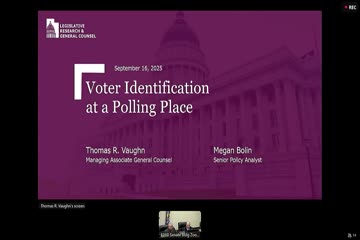Utah lawmakers study enhancements to voter ID laws during committee session
September 16, 2025 | 2025 Utah Legislature, Utah Legislature, Utah Legislative Branch, Utah
This article was created by AI summarizing key points discussed. AI makes mistakes, so for full details and context, please refer to the video of the full meeting. Please report any errors so we can fix them. Report an error »

In a recent meeting of the Government Operations Interim Committee, held on September 16, 2025, discussions centered around the complexities of voter identification laws in Utah. The atmosphere was charged with the importance of ensuring fair and accessible voting practices, as committee members delved into the nuances of current legislation and potential reforms.
The primary focus of the meeting was on voter ID requirements for in-person voting, specifically addressing what forms of identification are acceptable at polling places. Currently, Utah law mandates that voters present either a driver's license or a state-issued ID. If these are unavailable, voters can use secondary forms of ID, such as a passport or military ID, or provide two documents that verify their identity and residency, like a utility bill or bank statement. However, a significant change is on the horizon: House Bill 300, passed in the previous session, will repeal the use of utility bills as a form of ID by January 1, 2029.
Legal experts at the meeting highlighted the importance of understanding federal court rulings on voter ID laws, particularly the precedent set by the Supreme Court case Crawford v. Marion County Election Board. This case upheld Indiana's voter ID law, emphasizing that states must justify the need for such laws while ensuring they do not impose undue burdens on voters. The committee discussed how Utah's laws could be shaped to withstand similar legal scrutiny, suggesting that the inclusion of exceptions—such as allowing provisional ballots for those without ID—could bolster the law's constitutionality.
Megan, a legal analyst, provided a comparative overview of voter ID laws across the United States, noting that Utah currently falls into the category of non-photo ID states that require further action if a voter cannot present valid identification. This means voters can cast provisional ballots but must return with acceptable ID within a specified timeframe.
As the meeting progressed, the committee acknowledged the need for ongoing study and potential legislative action to refine Utah's voter ID laws. While no specific bill was introduced during this session, the discussions laid the groundwork for future proposals aimed at enhancing voter access and ensuring compliance with both state and federal regulations.
The committee's commitment to addressing these issues reflects a broader national conversation about voting rights and the balance between security and accessibility. As Utah navigates these complexities, the implications of their decisions will resonate beyond state lines, influencing the ongoing dialogue about democracy and representation in America.
The primary focus of the meeting was on voter ID requirements for in-person voting, specifically addressing what forms of identification are acceptable at polling places. Currently, Utah law mandates that voters present either a driver's license or a state-issued ID. If these are unavailable, voters can use secondary forms of ID, such as a passport or military ID, or provide two documents that verify their identity and residency, like a utility bill or bank statement. However, a significant change is on the horizon: House Bill 300, passed in the previous session, will repeal the use of utility bills as a form of ID by January 1, 2029.
Legal experts at the meeting highlighted the importance of understanding federal court rulings on voter ID laws, particularly the precedent set by the Supreme Court case Crawford v. Marion County Election Board. This case upheld Indiana's voter ID law, emphasizing that states must justify the need for such laws while ensuring they do not impose undue burdens on voters. The committee discussed how Utah's laws could be shaped to withstand similar legal scrutiny, suggesting that the inclusion of exceptions—such as allowing provisional ballots for those without ID—could bolster the law's constitutionality.
Megan, a legal analyst, provided a comparative overview of voter ID laws across the United States, noting that Utah currently falls into the category of non-photo ID states that require further action if a voter cannot present valid identification. This means voters can cast provisional ballots but must return with acceptable ID within a specified timeframe.
As the meeting progressed, the committee acknowledged the need for ongoing study and potential legislative action to refine Utah's voter ID laws. While no specific bill was introduced during this session, the discussions laid the groundwork for future proposals aimed at enhancing voter access and ensuring compliance with both state and federal regulations.
The committee's commitment to addressing these issues reflects a broader national conversation about voting rights and the balance between security and accessibility. As Utah navigates these complexities, the implications of their decisions will resonate beyond state lines, influencing the ongoing dialogue about democracy and representation in America.
View full meeting
This article is based on a recent meeting—watch the full video and explore the complete transcript for deeper insights into the discussion.
View full meeting

